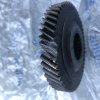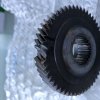Steve Hoelscher
True Classic
There always seems to be some interest in some of the odd things I find with X1/9 transmissions. So I though I would start a thread for that instead of posting this stuff elsewhere.
With this winter's round of transmission builds I have run across a couple of common issues I see regularly. I mentioned to Jim during his 128 4 speed build that a core he sent me was somewhat interesting and that I might post some pics on what I found.
First up is a somewhat common problem. One of the cores I got from a customer was in better than average condition and had never been apart. This is usually a good thing because I often find that the biggest problems I have to correct are errors from previous builders. And given the frailty and age of these transmissions a very high percentage have been apart before I get them.
In this instance, the unit hadn't been apart, I know because the driver's side (left) stub shaft would not come out of the case. This is not uncommon. I have an 8 lbs slide hammer setup specifically for pulling stub shafts. Now these can be quite stubborn to remove but I can typically get them out. Occasionally I can't and this was one of those times. I have an alternative means of using bolts to jack it out but even that failed. When this happens you can't get the case apart because the stub shaft has to come out to split the case. The only option then is to break the case. And given that good cases are becoming scarce, I hate to do that.

I use an air hammer to break the case between the diff housing and the stack housing. I can then remove the part of the case with the gearset and pull the two shaft. See above photo. Now I can pull the diff with the case and stub shaft.
I would like to salvage the stub shaft and diff assembly if possible so I rig the assembly in my press and press out the stub shaft. In this case, I maxed out my 20 ton press and it still wouldn't come out. So the entire diff carrier and case where scrapped.
In the photo below you are looking at the empty diff carrier, the bearing, the seal carrier and stub shaft. They won't come apart. And by now, even if they did they have been so highly stressed that I would never use them.

So, what should have been a great core to build produced only a rebuildable gearset and no case or diff. Fortunately, I have diff carriers but cases are scare now.
If you haven't seen a stub shaft this is what they look like. The snap rings fit in the grooves on at the end of the splines.

The above issue isn't due to an assembly error by a rebuilder. It was a retaining clip that was probably sprung when installed at the factory and fouled the shaft when I tried to remove it. Usually, once a stub shaft has been out they are quite easy to remove again and I seldom see this problem on units that have been rebuilt.
Another odd problem I run across is somebody improperly installing the speedo drive. One of the cores that Jim sent me had been rebuilt previously. The gearset was in reasonably good condition with no specific assembly faults but the case itself was another matter.
I found several minor issues with the case due to errors by a previous builder but the speedo drive had the potential for ruining the case.
When the drive was installed they didn't correctly clock the unit so that the allen screw retainer pin fit cleanly into its hole on the speedo drive. Because it didn't match up the hardened allen screw forced a new hole in the speedo drive body.
When I went to remove the drive it didn't want to come out. Now I had no way of knowing why and its not uncommon for these to be stubborn due to corrosion buildup. In this case it was the deformed steel speedo drive body dragging against the side of its bore in the aluminum case. If it had seriously gouged the bore it would be difficult at best to reseal and would cause a consistent leak.

This is what its supposed to look like.

This is the installation:

With this winter's round of transmission builds I have run across a couple of common issues I see regularly. I mentioned to Jim during his 128 4 speed build that a core he sent me was somewhat interesting and that I might post some pics on what I found.
First up is a somewhat common problem. One of the cores I got from a customer was in better than average condition and had never been apart. This is usually a good thing because I often find that the biggest problems I have to correct are errors from previous builders. And given the frailty and age of these transmissions a very high percentage have been apart before I get them.
In this instance, the unit hadn't been apart, I know because the driver's side (left) stub shaft would not come out of the case. This is not uncommon. I have an 8 lbs slide hammer setup specifically for pulling stub shafts. Now these can be quite stubborn to remove but I can typically get them out. Occasionally I can't and this was one of those times. I have an alternative means of using bolts to jack it out but even that failed. When this happens you can't get the case apart because the stub shaft has to come out to split the case. The only option then is to break the case. And given that good cases are becoming scarce, I hate to do that.
I use an air hammer to break the case between the diff housing and the stack housing. I can then remove the part of the case with the gearset and pull the two shaft. See above photo. Now I can pull the diff with the case and stub shaft.
I would like to salvage the stub shaft and diff assembly if possible so I rig the assembly in my press and press out the stub shaft. In this case, I maxed out my 20 ton press and it still wouldn't come out. So the entire diff carrier and case where scrapped.
In the photo below you are looking at the empty diff carrier, the bearing, the seal carrier and stub shaft. They won't come apart. And by now, even if they did they have been so highly stressed that I would never use them.
So, what should have been a great core to build produced only a rebuildable gearset and no case or diff. Fortunately, I have diff carriers but cases are scare now.
If you haven't seen a stub shaft this is what they look like. The snap rings fit in the grooves on at the end of the splines.
The above issue isn't due to an assembly error by a rebuilder. It was a retaining clip that was probably sprung when installed at the factory and fouled the shaft when I tried to remove it. Usually, once a stub shaft has been out they are quite easy to remove again and I seldom see this problem on units that have been rebuilt.
Another odd problem I run across is somebody improperly installing the speedo drive. One of the cores that Jim sent me had been rebuilt previously. The gearset was in reasonably good condition with no specific assembly faults but the case itself was another matter.
I found several minor issues with the case due to errors by a previous builder but the speedo drive had the potential for ruining the case.
When the drive was installed they didn't correctly clock the unit so that the allen screw retainer pin fit cleanly into its hole on the speedo drive. Because it didn't match up the hardened allen screw forced a new hole in the speedo drive body.
When I went to remove the drive it didn't want to come out. Now I had no way of knowing why and its not uncommon for these to be stubborn due to corrosion buildup. In this case it was the deformed steel speedo drive body dragging against the side of its bore in the aluminum case. If it had seriously gouged the bore it would be difficult at best to reseal and would cause a consistent leak.
This is what its supposed to look like.
This is the installation:
Last edited:


